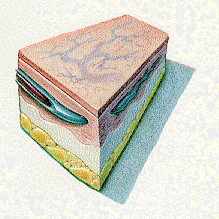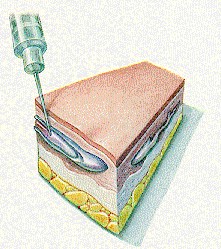Sclerotherapy
Spider veins or telangiectasias of the legs are a common problem that particularly affect women. Small purple, blue or red veins can form anywhere on the leg, from the top of the thigh to the ankle, and can sometimes occur on the face as well. These veins appear as connected lines resembling a sunburst or spider web pattern or as short, unconnected lines. On many people, they are relatively inconspicuous, because they are confined to a small area; however, some people become distressed when larger areas of skin are affected and the veins become more noticeable.
Varicose veins are larger. sometimes raised veins which are often blue in color. These are not the deep veins connected with the valve system; however, they can become quite painful, producing a burning or throbbing sensation. Although these superficial varicose veins and spider veins carry blood, neither are necessary to the circulatory system.
Today, because of modern technology, both telangiectasias and superficial varicose veins can be treated through a procedure called sclerotherapy. Sclerotherapy is a technique that involves the use of a very fine needle to inject a solution directly into the veins. The solution causes the blood within the vein to disappear or become less obvious.
Prior to treatment, a complete medical history is taken and a thorough examination made in order to determine, among other things, how long the problem has existed, the severity of the symptoms, whether or not the condition is affected by physical activity and if there has been prior surgery or treatment of the veins. The physician determines if the deep venous system is affected, in which case surgery may be recommended before sclerotherapy is undertaken. Preoperative instructions may include the elimination of certain drugs that contain aspirin in order to minimize the possibility of excess bleeding. The physician decides whether or not the area to be treated should be shaved. The veins are usually marked while the patient is in a standing position.

Before Treatment
Larger vein are usually treated first. After the skin is thoroughly cleansed with alcohol, the physician uses a syringe with a tiny needle to inject a small amount of sclerosing (hardening) solution directly into a vein. The solution displaces the blood within the vein, causing it to blanch or turn white. The solution then causes the vessel to become irritated and swell shut, prohibiting the blood from reentering the vein. When the needle is withdrawn, pressure is immediately applied to the area. The skin may be kneaded to help disperse the solution and reduce bruising. Each vein may require several injections and most disappear in two weeks to two months.
Following treatment
Patients who have had sclerotherapy have reported little discomfort. Some experience a slight to moderate burning sensation immediately after the injection but this disappears within a few seconds. An ointment to soothe the skin and relieve the burning may be used, and a pressure bandage may be applied to prevent post-injection bleeding. Some physicians prefer elastic stockings; others use compression bandages.
Patients are usually advised to resume normal activity immediately, although vigorous activity is discouraged for twenty-four hours. Walking is encouraged because it increases the blood flow through other veins. Elevation of the legs is usually not recommended unless large veins have been treated.
Most patients experience no adverse effects; however, some minor side effects have been reported. These include slight blistering which occurs when small amounts of the solution seep into the surrounding areas. These spots usually resolve in time or respond to treatment with bleaching agents.
Bruising around the treated area, which eventually disappears, can result if the veins are unusually weak. Fair skinned people tend to bruise more than do dark skinned people. Clots sometimes develop at the site of the injection. Although not a major cause for concern, it may be necessary to remove these clots within two weeks in order to allow the healing process to progress normally.
A small percentage of patients develops a network of tiny, pink vessels that turn white when pressure is applied. This condition, referred to as "matte telangiectasia" usually disappears without treatment; however, injection treatment may be necessary in some cases. Occasionally, there are allergic reactions to the solution which are treated immediately with antihistamines and other medications.
In some cases, spider veins recur and new spider veins present themselves. When large veins are treated, wearing support hose is recommended to prevent their recurrence.

After Treatment
What causes spider veins and varicose veins?
No one has determined for certain why some people are affected with spider veins and varicose veins and others are not; however. some families seem predisposed to the condition. Trauma to the leg in the form of blows or falls may contribute to the formation of these veins, and long periods of standing or sitting may also be causative factors. More women than men seem to develop this condition, perhaps as a result of pregnancy or because of hormones. Scientists have not discovered any clear-cut methods to prevent the onset of these telangieclasias, although some authorities believe that the use of support hose, weight control and exercise may be beneficial.
Today, thousands of people who have felt self-conscious or embarrassed by unsightly veins are delighted with the results they are getting from sclerotherapy treatment. Most patients experience from 60% to 80% improvement, although final results may not be apparent for several months.
Other treatments using the argon and carbon dioxide lasers have not proven particularly successful; however, recent development of the tunable dye laser, a laser that is used to treat blood vessels, may be very effective in the treatment of telangiectasias.
Will insurance pay for sclerotherapy treatment?
Most insurance companies do not pay for selerotherapy treatment if it is performed for cosmetic reasons. Some insurance companies do pay benefits it there is pain or discomfort which impedes activity. Each insurance carrier is different, and it is recommended that individuals check with their own agents to determine if there is coverage.
If you are interested in learning more about sclerotherapy, please call our office and we will be happy to answer your questions.